Financial Management Assignment - Detailed Solutions and Analysis
VerifiedAdded on 2021/06/18
|10
|2717
|12
Homework Assignment
AI Summary
This document presents a comprehensive solution to a financial management assignment. It begins with calculations related to the time value of money, including present and future value computations. The assignment then delves into portfolio analysis, calculating portfolio return and standard deviation. The solution further explores the concept of Internal Rate of Return (IRR) and Net Present Value (NPV), comparing and contrasting these capital budgeting techniques. The final section of the assignment is an essay discussing the importance of business ethics and corporate governance, using the Enron scandal as a case study to highlight the significance of ethical leadership, the impact of off-balance sheet liabilities, and the role of corporate governance mechanisms in preventing financial fraud. The essay also touches upon the deontological ethical perspective and the need for ethical training and assistance within organizations.
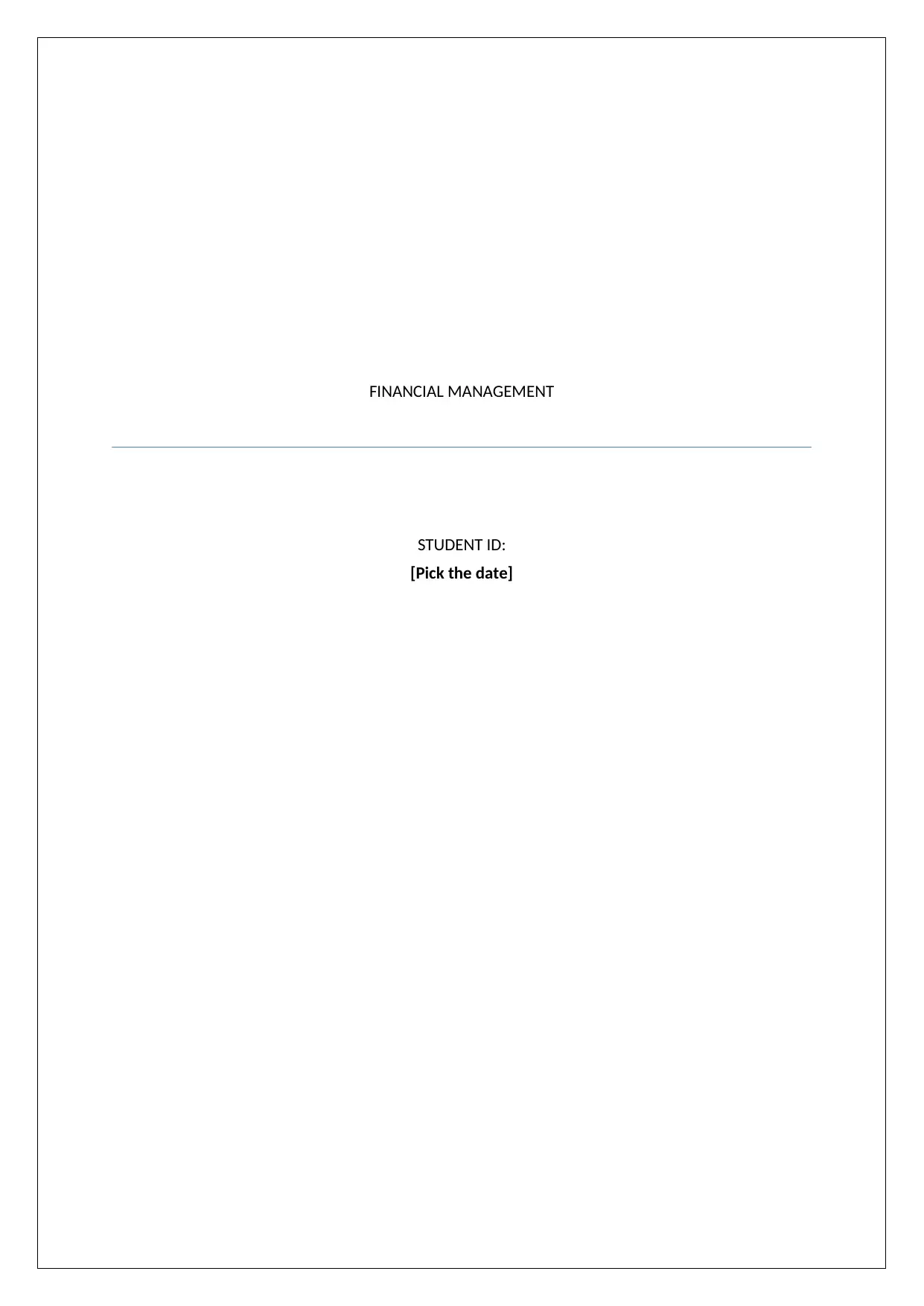
FINANCIAL MANAGEMENT
STUDENT ID:
[Pick the date]
STUDENT ID:
[Pick the date]
Paraphrase This Document
Need a fresh take? Get an instant paraphrase of this document with our AI Paraphraser

Question 1
a) The relevant formula to be used is as follows.
FVn = PV ( 1 + i )n
In the given case, PV = $ 3996, i = 5%, n= 25-18 = 7 years
Hence, amount at my 25th birthday if left untouched = 3996 *(1.05)7 = $ 5,622.77
b) Again the same formula would be used as indicated above.
In the given case, PV = $ 3996, i = 5%, n= 65-18 = 47 years
Hence, amount at my 65th birthday if left untouched = 3996 *(1.05)47 = $ 39.584.26
c) Let the amount put by my grandfather originally be X
FVn = PV ( 1 + i )n
In the given case, FV = $ 3996, i = 5%, n= 18-0= 18 years
Hence, 3996 = X*1.0518
Solving the above, X = $ 1,660.42
Thus, the original amount is $ 1,660.42.
Question 2
The ranking of the three alternatives provided would be done based on their present value
which can be found using the following formula.
PV = FVn/ ( 1 + i )n
a) $ 100 received in one year
PV = 100/1.1 = $ 90.91
$ 200 received in five years
a) The relevant formula to be used is as follows.
FVn = PV ( 1 + i )n
In the given case, PV = $ 3996, i = 5%, n= 25-18 = 7 years
Hence, amount at my 25th birthday if left untouched = 3996 *(1.05)7 = $ 5,622.77
b) Again the same formula would be used as indicated above.
In the given case, PV = $ 3996, i = 5%, n= 65-18 = 47 years
Hence, amount at my 65th birthday if left untouched = 3996 *(1.05)47 = $ 39.584.26
c) Let the amount put by my grandfather originally be X
FVn = PV ( 1 + i )n
In the given case, FV = $ 3996, i = 5%, n= 18-0= 18 years
Hence, 3996 = X*1.0518
Solving the above, X = $ 1,660.42
Thus, the original amount is $ 1,660.42.
Question 2
The ranking of the three alternatives provided would be done based on their present value
which can be found using the following formula.
PV = FVn/ ( 1 + i )n
a) $ 100 received in one year
PV = 100/1.1 = $ 90.91
$ 200 received in five years

PV = 200/1.15 = $124.18
$ 300 received in 10 years
PV = 300/1.110 = $ 115.66
Hence, the ranking is as shown below.
1) $ 200 received in five years (Most Valuable)
2) $ 300 received in 10 years
3) $ 100 received in one year (Least Valuable)
b) $ 100 received in one year
PV = 100/1.05 = $ 95.24
$ 200 received in five years
PV = 200/1.055 = $156.71
$ 300 received in 10 years
PV = 300/1.0510 = $ 184.17
Hence, the ranking is as shown below.
1) $ 300 received in 10 years (Most Valuable)
2) $ 200 received in five years
3) $ 100 received in one year (Least Valuable)
c) $ 100 received in one year
PV = 100/1.20 = $ 83.33
$ 200 received in five years
PV = 200/1.205 = $80.38
$ 300 received in 10 years
PV = 300/1.2010 = $ 48.45
$ 300 received in 10 years
PV = 300/1.110 = $ 115.66
Hence, the ranking is as shown below.
1) $ 200 received in five years (Most Valuable)
2) $ 300 received in 10 years
3) $ 100 received in one year (Least Valuable)
b) $ 100 received in one year
PV = 100/1.05 = $ 95.24
$ 200 received in five years
PV = 200/1.055 = $156.71
$ 300 received in 10 years
PV = 300/1.0510 = $ 184.17
Hence, the ranking is as shown below.
1) $ 300 received in 10 years (Most Valuable)
2) $ 200 received in five years
3) $ 100 received in one year (Least Valuable)
c) $ 100 received in one year
PV = 100/1.20 = $ 83.33
$ 200 received in five years
PV = 200/1.205 = $80.38
$ 300 received in 10 years
PV = 300/1.2010 = $ 48.45
⊘ This is a preview!⊘
Do you want full access?
Subscribe today to unlock all pages.

Trusted by 1+ million students worldwide

Hence, the ranking is as shown below.
1) $ 100 received in one year (Most Valuable)
2) $ 200 received in five years
3) $ 300 received in 10 years (Least Valuable)
Question 3
a) Portfolio Return = WA*E(RA) + WB*E(RB) = 0.5*7 + 0.5*10 = 8.5% p.a.
b) The standard deviation of portfolio is computed below.
σp = √(0.52*0.162 + 0.52*0.202 + 2*0.5*0.5*0.16*0.20*0.22) = 0.1411 or 14.11%
c) Expected portfolio return = WA*E(RA) + WB*E(RB) = 0.6*7 + 0.4*10 = 8.2% p.a.
Expected portfolio beta = WA*βA + WB* βB = 0.6*1.2 + 0.4*0.5 = 0.92
Question 4
a) IRR is that rate of interest or discount rate for which the NPV of the project becomes zero.
The formula for NPV is given below.
Let the assumed value of IRR for project A be x%. IRR computation for Project A is
indicated below.
0 = 25/(1+(x/100)) + 20/(1+(x/100))2 + 20/(1+(x/100))3 + 15/(1+(x/100))4 - 50
Solving the above, we get x= 24%
Let the assumed value of IRR for project B be y%. IRR computation for Project B is
indicated below.
0 = 20/(1+(y/100)) + 40/(1+(y/100))2 + 50/(1+(y/100))3 + 60/(1+(y/100))4 - 100
1) $ 100 received in one year (Most Valuable)
2) $ 200 received in five years
3) $ 300 received in 10 years (Least Valuable)
Question 3
a) Portfolio Return = WA*E(RA) + WB*E(RB) = 0.5*7 + 0.5*10 = 8.5% p.a.
b) The standard deviation of portfolio is computed below.
σp = √(0.52*0.162 + 0.52*0.202 + 2*0.5*0.5*0.16*0.20*0.22) = 0.1411 or 14.11%
c) Expected portfolio return = WA*E(RA) + WB*E(RB) = 0.6*7 + 0.4*10 = 8.2% p.a.
Expected portfolio beta = WA*βA + WB* βB = 0.6*1.2 + 0.4*0.5 = 0.92
Question 4
a) IRR is that rate of interest or discount rate for which the NPV of the project becomes zero.
The formula for NPV is given below.
Let the assumed value of IRR for project A be x%. IRR computation for Project A is
indicated below.
0 = 25/(1+(x/100)) + 20/(1+(x/100))2 + 20/(1+(x/100))3 + 15/(1+(x/100))4 - 50
Solving the above, we get x= 24%
Let the assumed value of IRR for project B be y%. IRR computation for Project B is
indicated below.
0 = 20/(1+(y/100)) + 40/(1+(y/100))2 + 50/(1+(y/100))3 + 60/(1+(y/100))4 - 100
Paraphrase This Document
Need a fresh take? Get an instant paraphrase of this document with our AI Paraphraser
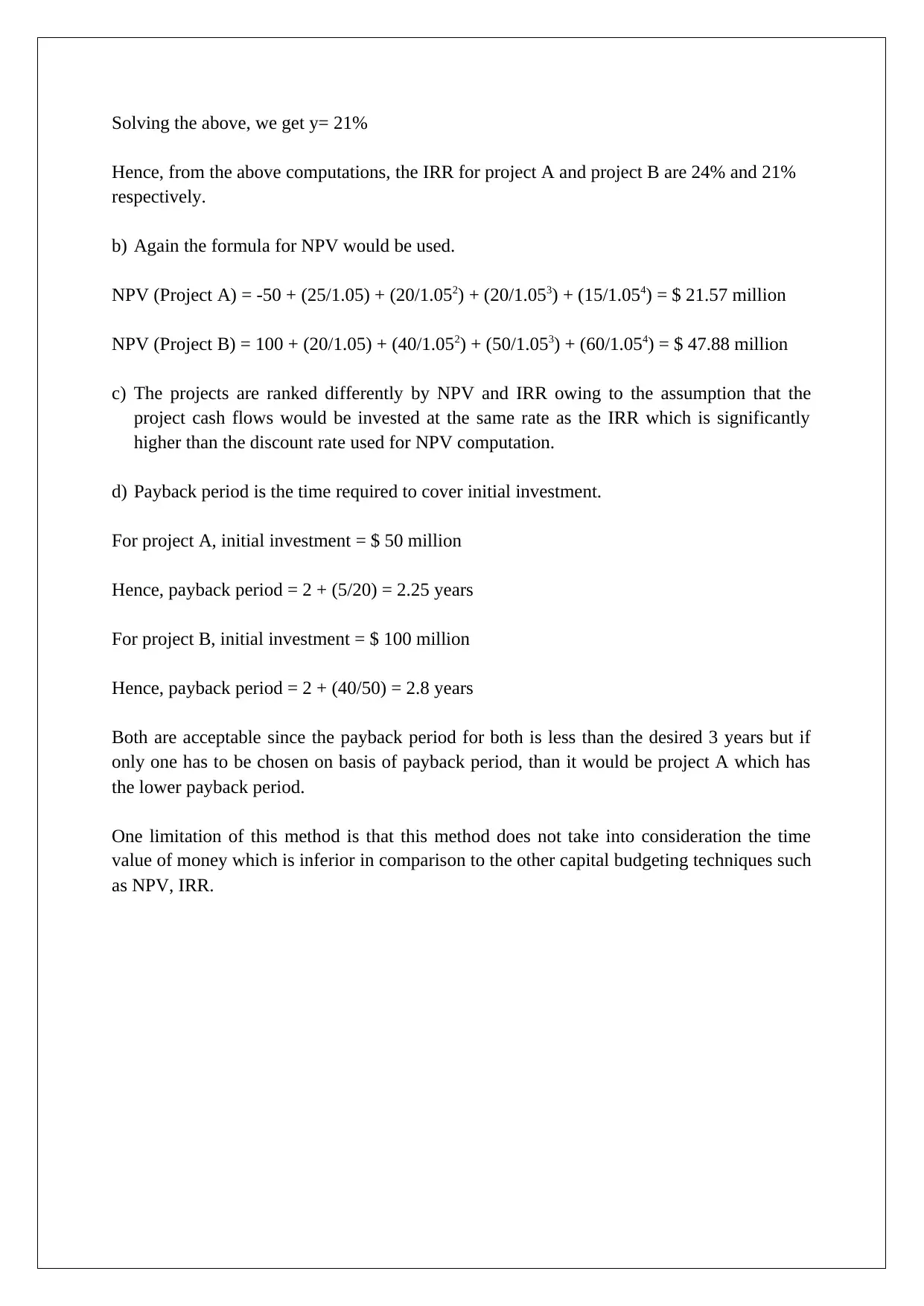
Solving the above, we get y= 21%
Hence, from the above computations, the IRR for project A and project B are 24% and 21%
respectively.
b) Again the formula for NPV would be used.
NPV (Project A) = -50 + (25/1.05) + (20/1.052) + (20/1.053) + (15/1.054) = $ 21.57 million
NPV (Project B) = 100 + (20/1.05) + (40/1.052) + (50/1.053) + (60/1.054) = $ 47.88 million
c) The projects are ranked differently by NPV and IRR owing to the assumption that the
project cash flows would be invested at the same rate as the IRR which is significantly
higher than the discount rate used for NPV computation.
d) Payback period is the time required to cover initial investment.
For project A, initial investment = $ 50 million
Hence, payback period = 2 + (5/20) = 2.25 years
For project B, initial investment = $ 100 million
Hence, payback period = 2 + (40/50) = 2.8 years
Both are acceptable since the payback period for both is less than the desired 3 years but if
only one has to be chosen on basis of payback period, than it would be project A which has
the lower payback period.
One limitation of this method is that this method does not take into consideration the time
value of money which is inferior in comparison to the other capital budgeting techniques such
as NPV, IRR.
Hence, from the above computations, the IRR for project A and project B are 24% and 21%
respectively.
b) Again the formula for NPV would be used.
NPV (Project A) = -50 + (25/1.05) + (20/1.052) + (20/1.053) + (15/1.054) = $ 21.57 million
NPV (Project B) = 100 + (20/1.05) + (40/1.052) + (50/1.053) + (60/1.054) = $ 47.88 million
c) The projects are ranked differently by NPV and IRR owing to the assumption that the
project cash flows would be invested at the same rate as the IRR which is significantly
higher than the discount rate used for NPV computation.
d) Payback period is the time required to cover initial investment.
For project A, initial investment = $ 50 million
Hence, payback period = 2 + (5/20) = 2.25 years
For project B, initial investment = $ 100 million
Hence, payback period = 2 + (40/50) = 2.8 years
Both are acceptable since the payback period for both is less than the desired 3 years but if
only one has to be chosen on basis of payback period, than it would be project A which has
the lower payback period.
One limitation of this method is that this method does not take into consideration the time
value of money which is inferior in comparison to the other capital budgeting techniques such
as NPV, IRR.
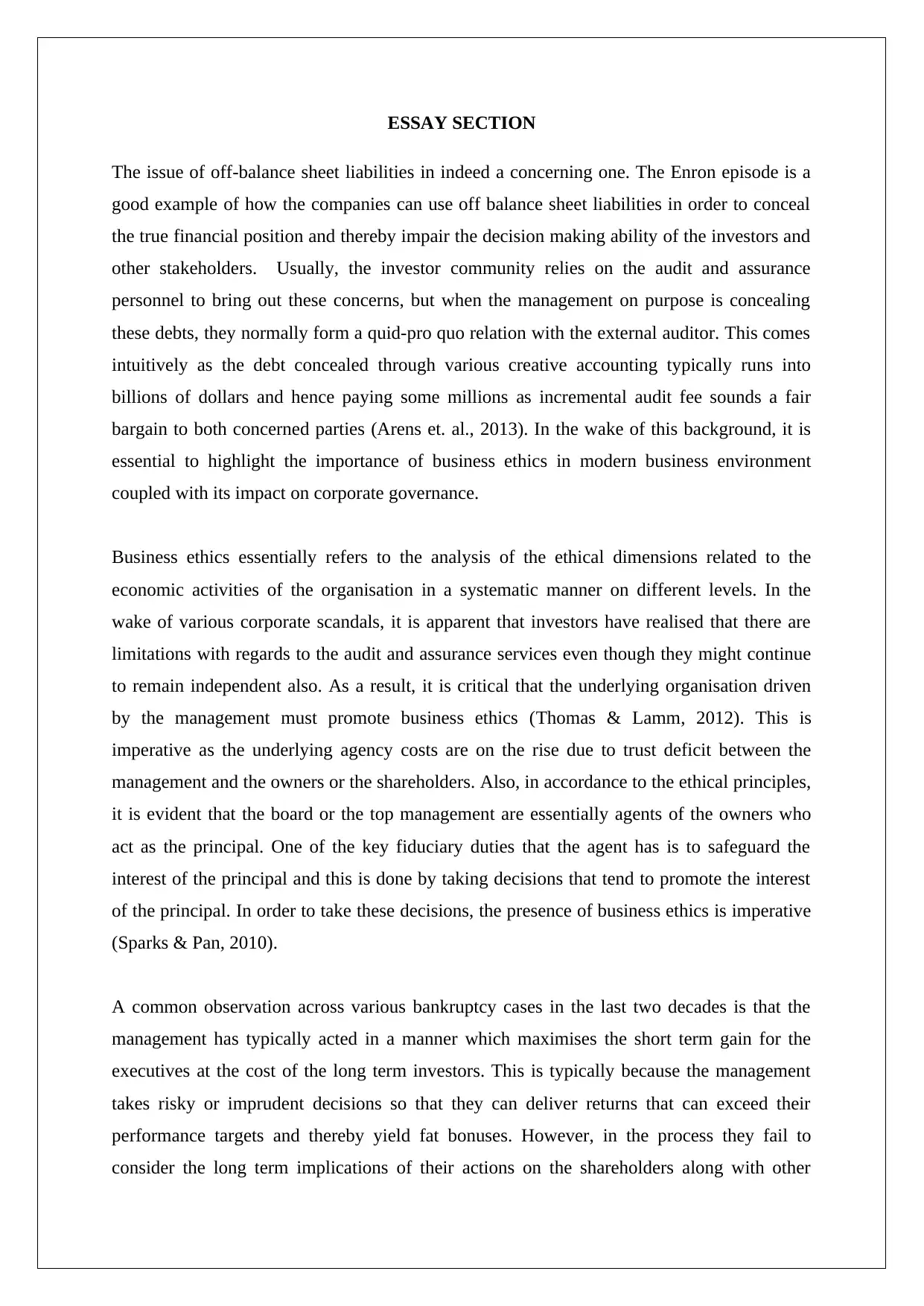
ESSAY SECTION
The issue of off-balance sheet liabilities in indeed a concerning one. The Enron episode is a
good example of how the companies can use off balance sheet liabilities in order to conceal
the true financial position and thereby impair the decision making ability of the investors and
other stakeholders. Usually, the investor community relies on the audit and assurance
personnel to bring out these concerns, but when the management on purpose is concealing
these debts, they normally form a quid-pro quo relation with the external auditor. This comes
intuitively as the debt concealed through various creative accounting typically runs into
billions of dollars and hence paying some millions as incremental audit fee sounds a fair
bargain to both concerned parties (Arens et. al., 2013). In the wake of this background, it is
essential to highlight the importance of business ethics in modern business environment
coupled with its impact on corporate governance.
Business ethics essentially refers to the analysis of the ethical dimensions related to the
economic activities of the organisation in a systematic manner on different levels. In the
wake of various corporate scandals, it is apparent that investors have realised that there are
limitations with regards to the audit and assurance services even though they might continue
to remain independent also. As a result, it is critical that the underlying organisation driven
by the management must promote business ethics (Thomas & Lamm, 2012). This is
imperative as the underlying agency costs are on the rise due to trust deficit between the
management and the owners or the shareholders. Also, in accordance to the ethical principles,
it is evident that the board or the top management are essentially agents of the owners who
act as the principal. One of the key fiduciary duties that the agent has is to safeguard the
interest of the principal and this is done by taking decisions that tend to promote the interest
of the principal. In order to take these decisions, the presence of business ethics is imperative
(Sparks & Pan, 2010).
A common observation across various bankruptcy cases in the last two decades is that the
management has typically acted in a manner which maximises the short term gain for the
executives at the cost of the long term investors. This is typically because the management
takes risky or imprudent decisions so that they can deliver returns that can exceed their
performance targets and thereby yield fat bonuses. However, in the process they fail to
consider the long term implications of their actions on the shareholders along with other
The issue of off-balance sheet liabilities in indeed a concerning one. The Enron episode is a
good example of how the companies can use off balance sheet liabilities in order to conceal
the true financial position and thereby impair the decision making ability of the investors and
other stakeholders. Usually, the investor community relies on the audit and assurance
personnel to bring out these concerns, but when the management on purpose is concealing
these debts, they normally form a quid-pro quo relation with the external auditor. This comes
intuitively as the debt concealed through various creative accounting typically runs into
billions of dollars and hence paying some millions as incremental audit fee sounds a fair
bargain to both concerned parties (Arens et. al., 2013). In the wake of this background, it is
essential to highlight the importance of business ethics in modern business environment
coupled with its impact on corporate governance.
Business ethics essentially refers to the analysis of the ethical dimensions related to the
economic activities of the organisation in a systematic manner on different levels. In the
wake of various corporate scandals, it is apparent that investors have realised that there are
limitations with regards to the audit and assurance services even though they might continue
to remain independent also. As a result, it is critical that the underlying organisation driven
by the management must promote business ethics (Thomas & Lamm, 2012). This is
imperative as the underlying agency costs are on the rise due to trust deficit between the
management and the owners or the shareholders. Also, in accordance to the ethical principles,
it is evident that the board or the top management are essentially agents of the owners who
act as the principal. One of the key fiduciary duties that the agent has is to safeguard the
interest of the principal and this is done by taking decisions that tend to promote the interest
of the principal. In order to take these decisions, the presence of business ethics is imperative
(Sparks & Pan, 2010).
A common observation across various bankruptcy cases in the last two decades is that the
management has typically acted in a manner which maximises the short term gain for the
executives at the cost of the long term investors. This is typically because the management
takes risky or imprudent decisions so that they can deliver returns that can exceed their
performance targets and thereby yield fat bonuses. However, in the process they fail to
consider the long term implications of their actions on the shareholders along with other
⊘ This is a preview!⊘
Do you want full access?
Subscribe today to unlock all pages.

Trusted by 1+ million students worldwide
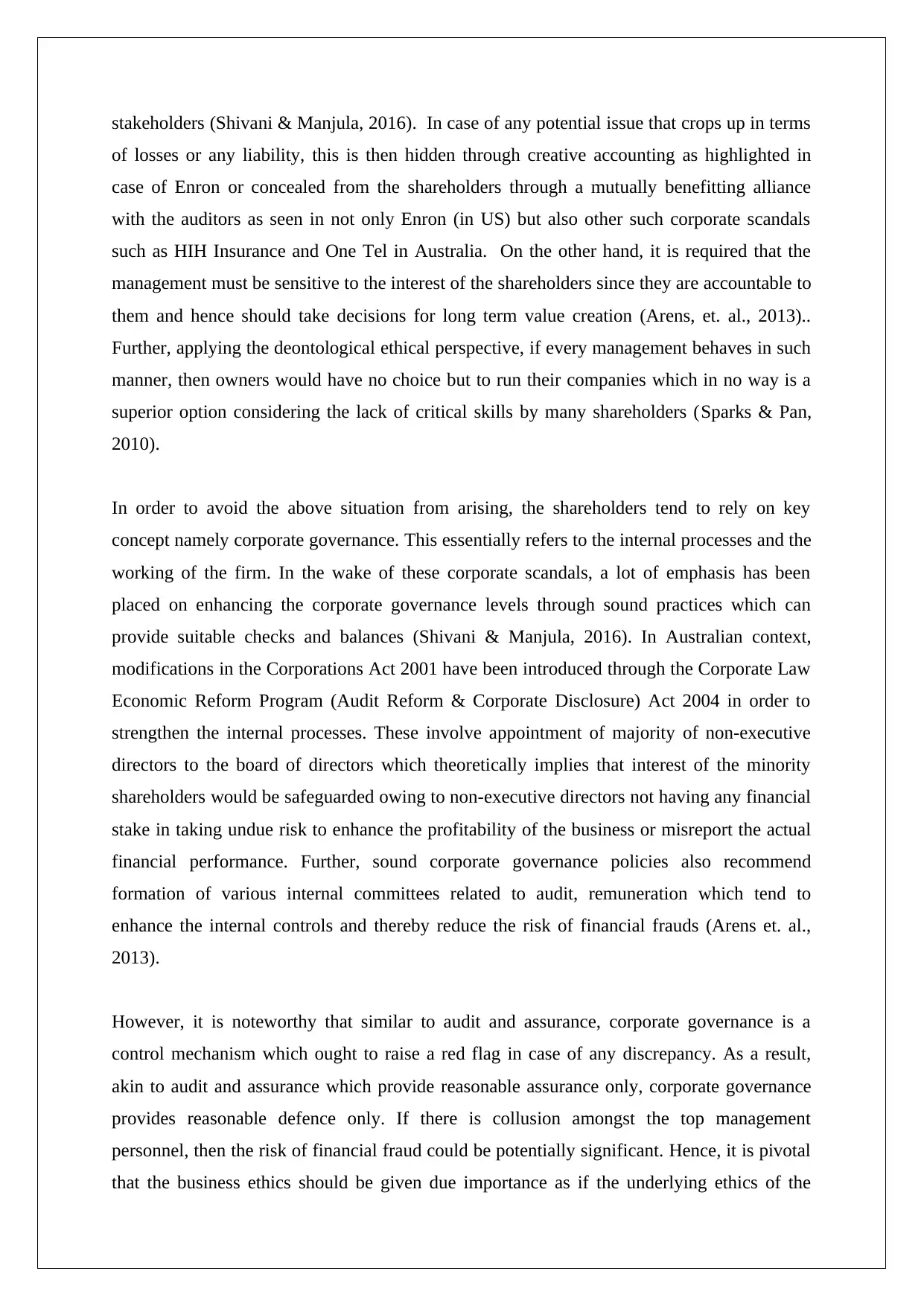
stakeholders (Shivani & Manjula, 2016). In case of any potential issue that crops up in terms
of losses or any liability, this is then hidden through creative accounting as highlighted in
case of Enron or concealed from the shareholders through a mutually benefitting alliance
with the auditors as seen in not only Enron (in US) but also other such corporate scandals
such as HIH Insurance and One Tel in Australia. On the other hand, it is required that the
management must be sensitive to the interest of the shareholders since they are accountable to
them and hence should take decisions for long term value creation (Arens, et. al., 2013)..
Further, applying the deontological ethical perspective, if every management behaves in such
manner, then owners would have no choice but to run their companies which in no way is a
superior option considering the lack of critical skills by many shareholders (Sparks & Pan,
2010).
In order to avoid the above situation from arising, the shareholders tend to rely on key
concept namely corporate governance. This essentially refers to the internal processes and the
working of the firm. In the wake of these corporate scandals, a lot of emphasis has been
placed on enhancing the corporate governance levels through sound practices which can
provide suitable checks and balances (Shivani & Manjula, 2016). In Australian context,
modifications in the Corporations Act 2001 have been introduced through the Corporate Law
Economic Reform Program (Audit Reform & Corporate Disclosure) Act 2004 in order to
strengthen the internal processes. These involve appointment of majority of non-executive
directors to the board of directors which theoretically implies that interest of the minority
shareholders would be safeguarded owing to non-executive directors not having any financial
stake in taking undue risk to enhance the profitability of the business or misreport the actual
financial performance. Further, sound corporate governance policies also recommend
formation of various internal committees related to audit, remuneration which tend to
enhance the internal controls and thereby reduce the risk of financial frauds (Arens et. al.,
2013).
However, it is noteworthy that similar to audit and assurance, corporate governance is a
control mechanism which ought to raise a red flag in case of any discrepancy. As a result,
akin to audit and assurance which provide reasonable assurance only, corporate governance
provides reasonable defence only. If there is collusion amongst the top management
personnel, then the risk of financial fraud could be potentially significant. Hence, it is pivotal
that the business ethics should be given due importance as if the underlying ethics of the
of losses or any liability, this is then hidden through creative accounting as highlighted in
case of Enron or concealed from the shareholders through a mutually benefitting alliance
with the auditors as seen in not only Enron (in US) but also other such corporate scandals
such as HIH Insurance and One Tel in Australia. On the other hand, it is required that the
management must be sensitive to the interest of the shareholders since they are accountable to
them and hence should take decisions for long term value creation (Arens, et. al., 2013)..
Further, applying the deontological ethical perspective, if every management behaves in such
manner, then owners would have no choice but to run their companies which in no way is a
superior option considering the lack of critical skills by many shareholders (Sparks & Pan,
2010).
In order to avoid the above situation from arising, the shareholders tend to rely on key
concept namely corporate governance. This essentially refers to the internal processes and the
working of the firm. In the wake of these corporate scandals, a lot of emphasis has been
placed on enhancing the corporate governance levels through sound practices which can
provide suitable checks and balances (Shivani & Manjula, 2016). In Australian context,
modifications in the Corporations Act 2001 have been introduced through the Corporate Law
Economic Reform Program (Audit Reform & Corporate Disclosure) Act 2004 in order to
strengthen the internal processes. These involve appointment of majority of non-executive
directors to the board of directors which theoretically implies that interest of the minority
shareholders would be safeguarded owing to non-executive directors not having any financial
stake in taking undue risk to enhance the profitability of the business or misreport the actual
financial performance. Further, sound corporate governance policies also recommend
formation of various internal committees related to audit, remuneration which tend to
enhance the internal controls and thereby reduce the risk of financial frauds (Arens et. al.,
2013).
However, it is noteworthy that similar to audit and assurance, corporate governance is a
control mechanism which ought to raise a red flag in case of any discrepancy. As a result,
akin to audit and assurance which provide reasonable assurance only, corporate governance
provides reasonable defence only. If there is collusion amongst the top management
personnel, then the risk of financial fraud could be potentially significant. Hence, it is pivotal
that the business ethics should be given due importance as if the underlying ethics of the
Paraphrase This Document
Need a fresh take? Get an instant paraphrase of this document with our AI Paraphraser
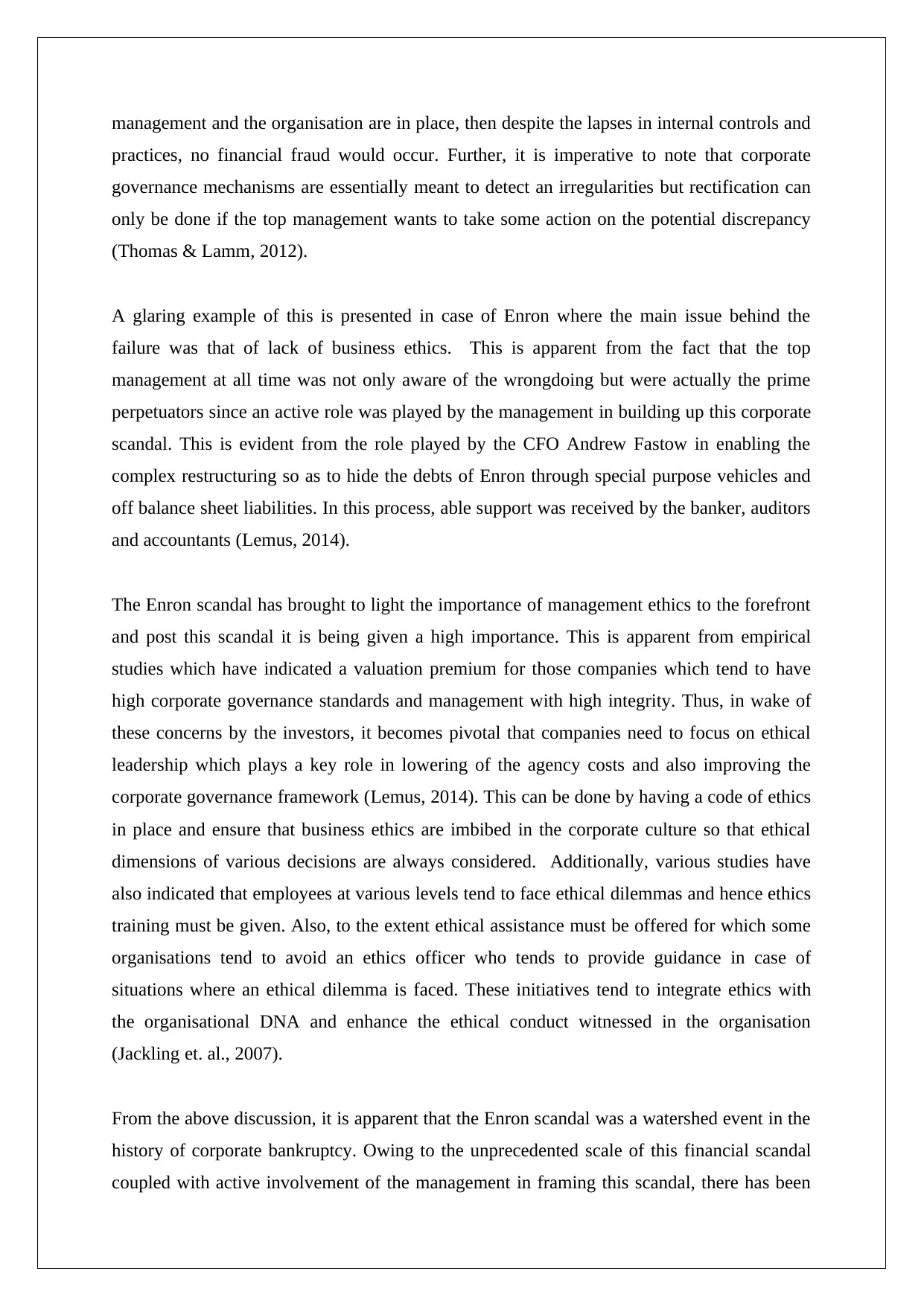
management and the organisation are in place, then despite the lapses in internal controls and
practices, no financial fraud would occur. Further, it is imperative to note that corporate
governance mechanisms are essentially meant to detect an irregularities but rectification can
only be done if the top management wants to take some action on the potential discrepancy
(Thomas & Lamm, 2012).
A glaring example of this is presented in case of Enron where the main issue behind the
failure was that of lack of business ethics. This is apparent from the fact that the top
management at all time was not only aware of the wrongdoing but were actually the prime
perpetuators since an active role was played by the management in building up this corporate
scandal. This is evident from the role played by the CFO Andrew Fastow in enabling the
complex restructuring so as to hide the debts of Enron through special purpose vehicles and
off balance sheet liabilities. In this process, able support was received by the banker, auditors
and accountants (Lemus, 2014).
The Enron scandal has brought to light the importance of management ethics to the forefront
and post this scandal it is being given a high importance. This is apparent from empirical
studies which have indicated a valuation premium for those companies which tend to have
high corporate governance standards and management with high integrity. Thus, in wake of
these concerns by the investors, it becomes pivotal that companies need to focus on ethical
leadership which plays a key role in lowering of the agency costs and also improving the
corporate governance framework (Lemus, 2014). This can be done by having a code of ethics
in place and ensure that business ethics are imbibed in the corporate culture so that ethical
dimensions of various decisions are always considered. Additionally, various studies have
also indicated that employees at various levels tend to face ethical dilemmas and hence ethics
training must be given. Also, to the extent ethical assistance must be offered for which some
organisations tend to avoid an ethics officer who tends to provide guidance in case of
situations where an ethical dilemma is faced. These initiatives tend to integrate ethics with
the organisational DNA and enhance the ethical conduct witnessed in the organisation
(Jackling et. al., 2007).
From the above discussion, it is apparent that the Enron scandal was a watershed event in the
history of corporate bankruptcy. Owing to the unprecedented scale of this financial scandal
coupled with active involvement of the management in framing this scandal, there has been
practices, no financial fraud would occur. Further, it is imperative to note that corporate
governance mechanisms are essentially meant to detect an irregularities but rectification can
only be done if the top management wants to take some action on the potential discrepancy
(Thomas & Lamm, 2012).
A glaring example of this is presented in case of Enron where the main issue behind the
failure was that of lack of business ethics. This is apparent from the fact that the top
management at all time was not only aware of the wrongdoing but were actually the prime
perpetuators since an active role was played by the management in building up this corporate
scandal. This is evident from the role played by the CFO Andrew Fastow in enabling the
complex restructuring so as to hide the debts of Enron through special purpose vehicles and
off balance sheet liabilities. In this process, able support was received by the banker, auditors
and accountants (Lemus, 2014).
The Enron scandal has brought to light the importance of management ethics to the forefront
and post this scandal it is being given a high importance. This is apparent from empirical
studies which have indicated a valuation premium for those companies which tend to have
high corporate governance standards and management with high integrity. Thus, in wake of
these concerns by the investors, it becomes pivotal that companies need to focus on ethical
leadership which plays a key role in lowering of the agency costs and also improving the
corporate governance framework (Lemus, 2014). This can be done by having a code of ethics
in place and ensure that business ethics are imbibed in the corporate culture so that ethical
dimensions of various decisions are always considered. Additionally, various studies have
also indicated that employees at various levels tend to face ethical dilemmas and hence ethics
training must be given. Also, to the extent ethical assistance must be offered for which some
organisations tend to avoid an ethics officer who tends to provide guidance in case of
situations where an ethical dilemma is faced. These initiatives tend to integrate ethics with
the organisational DNA and enhance the ethical conduct witnessed in the organisation
(Jackling et. al., 2007).
From the above discussion, it is apparent that the Enron scandal was a watershed event in the
history of corporate bankruptcy. Owing to the unprecedented scale of this financial scandal
coupled with active involvement of the management in framing this scandal, there has been
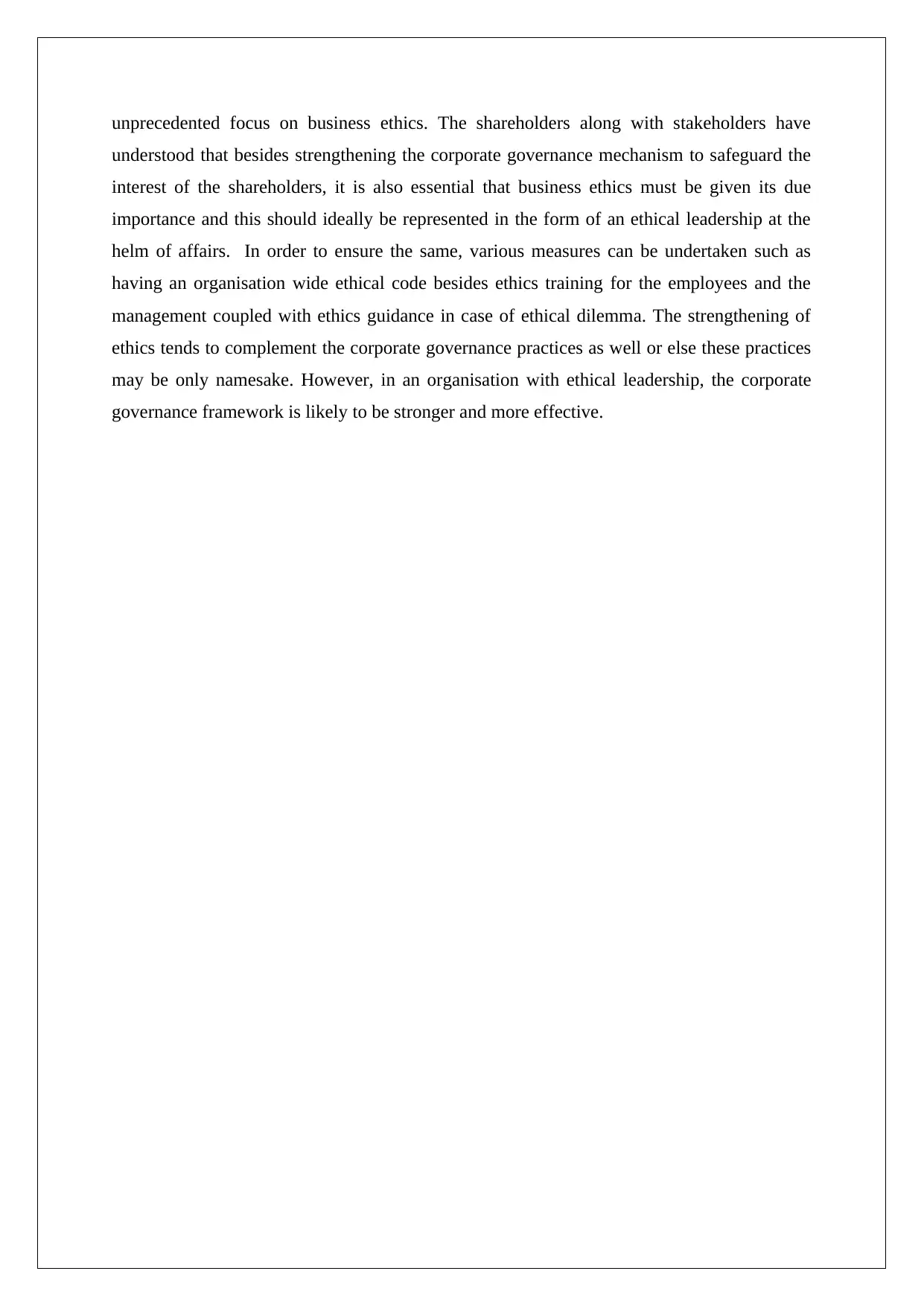
unprecedented focus on business ethics. The shareholders along with stakeholders have
understood that besides strengthening the corporate governance mechanism to safeguard the
interest of the shareholders, it is also essential that business ethics must be given its due
importance and this should ideally be represented in the form of an ethical leadership at the
helm of affairs. In order to ensure the same, various measures can be undertaken such as
having an organisation wide ethical code besides ethics training for the employees and the
management coupled with ethics guidance in case of ethical dilemma. The strengthening of
ethics tends to complement the corporate governance practices as well or else these practices
may be only namesake. However, in an organisation with ethical leadership, the corporate
governance framework is likely to be stronger and more effective.
understood that besides strengthening the corporate governance mechanism to safeguard the
interest of the shareholders, it is also essential that business ethics must be given its due
importance and this should ideally be represented in the form of an ethical leadership at the
helm of affairs. In order to ensure the same, various measures can be undertaken such as
having an organisation wide ethical code besides ethics training for the employees and the
management coupled with ethics guidance in case of ethical dilemma. The strengthening of
ethics tends to complement the corporate governance practices as well or else these practices
may be only namesake. However, in an organisation with ethical leadership, the corporate
governance framework is likely to be stronger and more effective.
⊘ This is a preview!⊘
Do you want full access?
Subscribe today to unlock all pages.

Trusted by 1+ million students worldwide

References
Arens, A., Best, P., Shailer, G. and Fiedler,I. (2013). Auditing, Assurance Services and Ethics
in Australia, 2nd eds., Sydney: Pearson Australia
Jackling, B., Cooper, B. J., Leung, P., & Dellaportas, S. (2007). Professional accounting
bodies' perceptions of ethical issues, causes of ethical failure and ethics education.
Managerial Auditing Journal, 22(9), 928-944
Lemus, E. (June, 2014). The Financial Collapse of the Enron Corporation and its Impact in
the United States Capital Market. Global Journal of Management and Business
Research, 14(5), 328-339
Shivani, T. & Manjula, S. (2016) Corporate Governance & Business Ethics: Challenges &
Responsibilities, International Journal of Research in Finance and Marketing, 6(3),
137-153
Sparks, J. R., & Pan, Y. (2010). Ethical judgments in business ethics research: Definition, and
research agenda. Journal of Business Ethics, 91(3), 405-418
Thomas, T. E., & Lamm, E. (2012). Legitimacy and organizational sustainability. Journal of
Business Ethics, 110(2), 191–203
Arens, A., Best, P., Shailer, G. and Fiedler,I. (2013). Auditing, Assurance Services and Ethics
in Australia, 2nd eds., Sydney: Pearson Australia
Jackling, B., Cooper, B. J., Leung, P., & Dellaportas, S. (2007). Professional accounting
bodies' perceptions of ethical issues, causes of ethical failure and ethics education.
Managerial Auditing Journal, 22(9), 928-944
Lemus, E. (June, 2014). The Financial Collapse of the Enron Corporation and its Impact in
the United States Capital Market. Global Journal of Management and Business
Research, 14(5), 328-339
Shivani, T. & Manjula, S. (2016) Corporate Governance & Business Ethics: Challenges &
Responsibilities, International Journal of Research in Finance and Marketing, 6(3),
137-153
Sparks, J. R., & Pan, Y. (2010). Ethical judgments in business ethics research: Definition, and
research agenda. Journal of Business Ethics, 91(3), 405-418
Thomas, T. E., & Lamm, E. (2012). Legitimacy and organizational sustainability. Journal of
Business Ethics, 110(2), 191–203
1 out of 10
Your All-in-One AI-Powered Toolkit for Academic Success.
+13062052269
info@desklib.com
Available 24*7 on WhatsApp / Email
![[object Object]](/_next/static/media/star-bottom.7253800d.svg)
Unlock your academic potential
Copyright © 2020–2025 A2Z Services. All Rights Reserved. Developed and managed by ZUCOL.